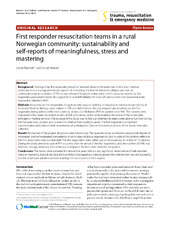First responder resuscitation teams in a rural Norwegian community: sustainability and self-reports of meaningfulness, stress and mastering
| dc.contributor.author | Rørtveit, Sverre | en_US |
| dc.contributor.author | Meland, Eivind | en_US |
| dc.date.accessioned | 2016-10-27T11:57:20Z | |
| dc.date.available | 2016-10-27T11:57:20Z | |
| dc.date.issued | 2010-05-04 | |
| dc.identifier.issn | 1757-7241 | |
| dc.identifier.uri | https://hdl.handle.net/1956/13019 | |
| dc.description.abstract | Background: Training of lay first responder personnel situated closer to the potential victims than medical professionals is a strategy potentially capable of shortening the interval between collapse and start of cardiopulmonary resuscitation (CPR) in cases of out-of-hospital cardiac arrest. In this study we trained lay first responders personnel in basic life support (BLS) and defibrillation for cases of cardiac arrest and suspected acute myocardial infarction (AMI). Methods: Forty-two lay first responders living in remote areas or working in industries in the island community of Austevoll, Western Norway, were trained in CPR and defibrillation. We placed particular emphasis on the first responders being able to defibrillate a primary ventricular fibrillation (PVF) in patients with AMI. The trainees were organised in four teams to attend victims of AMI and cardiac arrest while awaiting the arrival of the community emergency medical services. The purpose of the study was to find out whether the teams were able to function during the five-year study project, and to examine whether lives could be saved. The first responders completed questionnaires each year on their experiences of participation. Data on the medical actions of the teams were also collected. Results: By the end of the project all groups were functioning. The questionnaires evidenced a reasonable degree of motivation and self-evaluated competence in both types of group organisation, but in spite of this attrition effects in the first responders were considerable. The first responders were called out on 24 occasions, for a total of 17 patients. During the study period no case of PVF occurred after the arrival of the first responders, and the number of AMIs was very low, strongly deviating from what was anticipated. No lives were saved by the project. Conclusions: The teams were sustained for almost five years without any significant deterioration of self-reported stress or mastering, but still showed attrition effects. Evaluated as a medical project the intervention was not successful, but the small scale prevents us from drawing firm conclusions on this aspect. | en_US |
| dc.language.iso | eng | eng |
| dc.publisher | BioMed Central Ltd. | eng |
| dc.relation.ispartof | <a href="http://hdl.handle.net/1956/13018" target="blank">Akuttmedisin i ein distriktskommune</a> | |
| dc.rights | This is an Open Access article distributed under the terms of the Creative Commons Attribution License (http://creativecommons.org/licenses/by/2.0), which permits unrestricted use, distribution, and reproduction in any medium, provided the original work is properly cited. | eng |
| dc.rights.uri | http://creativecommons.org/licenses/by/2.0 | eng |
| dc.title | First responder resuscitation teams in a rural Norwegian community: sustainability and self-reports of meaningfulness, stress and mastering | en_US |
| dc.type | Peer reviewed | |
| dc.type | Journal article | |
| dc.description.version | publishedVersion | en_US |
| dc.rights.holder | Copyright 2010 Rørtveit and Meland; licensee BioMed Central Ltd. | |
| dc.identifier.doi | https://doi.org/10.1186/1757-7241-18-25 | |
| dc.source.journal | Scandinavian Journal of Trauma, Resuscitation and Emergency Medicine | |
| dc.source.40 | 18 | |
| dc.source.14 | 25 | |
| dc.subject.nsi | VDP::Medisinske Fag: 700::Klinisk medisinske fag: 750::Allmennmedisin: 751 | en_US |
Tilhørende fil(er)
Denne innførselen finnes i følgende samling(er)
Med mindre annet er angitt, så er denne innførselen lisensiert som This is an Open Access article distributed under the terms of the Creative Commons Attribution License (http://creativecommons.org/licenses/by/2.0), which permits unrestricted use, distribution, and reproduction in any medium, provided the original work is properly cited.

